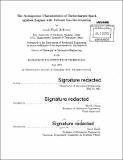The autoignition characteristics of turbocharged spark ignition engines with exhaust gas recirculation
Author(s)
McKenzie, Jacob Elijah
DownloadFull printable version (22.76Mb)
Other Contributors
Massachusetts Institute of Technology. Department of Mechanical Engineering.
Advisor
Wai K. Cheng.
Terms of use
Metadata
Show full item recordAbstract
The societal demand for vehicles with high efficiency and low emissions has spurred considerable changes to the automotive internal combustion engine within the past decade. Reductions in the displacement volume and increases in maximum output per unit of displacement are among the characteristics adopted to meet the fuel economy targets of world governments. However, the extent to which these changes in engine configuration may be pursued in search of efficiency is limited by several fundamental phenomena. The intent of this research project is to investigate the modeling of one of these phenomena - the autoignition of an unburned portion of the air-fuel mixture - and a potential strategy intended to delay the occurrence of this frequently damaging type of combustion reaction. The autoignition abatement approach studied entails the recirculation of burned exhaust gasses which serve to dilute the air-fuel mixture and reduce maximum unburned gas temperatures Experimental testing was performed on two different types of exhaust gas recirculation (EGR) system - one which extracts exhaust gases from upstream of the catalytic converter and another which extracts gases from downstream - in order to determine if the changes in composition that occur across the catalyst affect the autoignition abatement characteristics of the recirculated exhaust. This testing indicated that differences between the alternative installations are dominated by changes in the flow dynamics of the exhaust system, with no definite changes attributable to compositional differences. An empirical method of predicting the occurrence of autoignition using experimental data was then developed based on an approach originally proposed by Livengood and Wu. Ignition delay correlations were developed that provide accurate autoignition prediction over a range of speeds, loads, air-fuel equivalence ratios and dilution rates. Additionally, a new statistical model for autoignition is proposed that captures the cycle-to-cycle variation in autoignition intensity and relates these variations to the thermodynamic state of the charge.
Description
Thesis: Ph. D., Massachusetts Institute of Technology, Department of Mechanical Engineering, 2015. Cataloged from PDF version of thesis. Page 145 blank. Includes bibliographical references (pages 131-134).
Date issued
2015Department
Massachusetts Institute of Technology. Department of Mechanical EngineeringPublisher
Massachusetts Institute of Technology
Keywords
Mechanical Engineering.